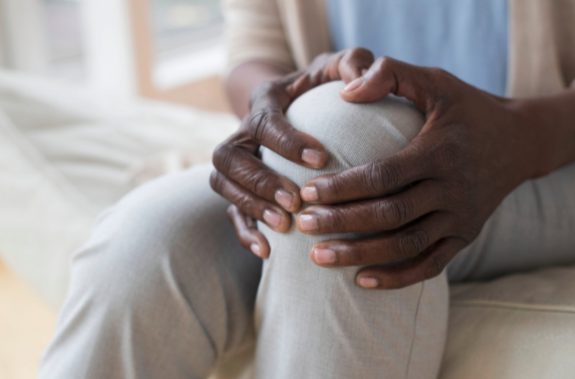
Arthritis is a complex condition and according to the NHS, over 10 million people live with arthritis in the UK alone. Despite this staggering number of people who live with arthritis, the general population still believes in some myths about the disease.
There are over 100 types of arthritis affecting a vast range of people globally. Arthritis does not discriminate against age, sex or race – it really can affect anyone. Despite being known to mainly affect joints it also impacts the heart, immune system, lungs and other organs.
So here we are going to identify and debunk the most common myths about arthritis – it’s important to know the reality of the condition and those living with it.

Myth: Arthritis only affects old people
Reality: There are over 100 types of arthritis and all of them are very different.
While the risk of arthritis increases as you age – half of those 65 and older have arthritis – the truth is people of all ages can get arthritis, including young adults and children.
In the UK, around 15,000 children and young people are struggling with Juvenile Idiopathic Arthritis (JIA), a case of inflammation in joints. However, many people still believe that arthritis is an illness that only affects older people.
This widely believed myth results in young people with arthritis having to constantly explain their condition to others, meaning friends and family might not understand or do not want to acknowledge how the illness negatively impacts their lives, which can be exhausting and emotionally taxing.
Eileen was 29 years old when she was diagnosed with rheumatoid arthritis. She had to struggle first with the disbelief and shame out of her diagnosis. As a new and healthy-looking mom, she didn’t know how to communicate her condition with the people around her until she decided that the best way to fight the illness was to acknowledge it and educate herself and those around her.
Myth: Arthritis can always be treated with medication and surgery
Reality: Today’s medical advancements have afforded arthritis sufferers many options, but that doesn’t mean their problems are magically solved.
Medication is widely available for many types of arthritis but prolonged use could potentially trigger a range of side effects while the option of surgery often entails a process not everyone wants to endure especially when it doesn’t always offer a curative solution.
Even though getting the right kind and dosage of prescription medication may take much trial-and-error, there are many complementary therapies you can try. By trying new things and keeping up-to-date on alternative and fun ways to relieve pain, you never know which treatment might end up working for you.
While a lifestyle change such as changing your diet, practising yoga, or taking up music therapy might be beneficial to reduce pain, To Better Days patches could also offer an natural alternative to provide relief. Using a patented combination of dextrose and vitamin D, To Better Days active patches offer a topical and targeted relief for those experiencing prolonged discomfort and chronic pain.
Tom uses To Better Days patches to help sooth his arthritic wrist and hip pain. He had previously been prescribed a strong anti-inflammatory medicine called Meloxicam that helped, but the side effect was kidney function problems.
His doctor said the next option would be for surgery to fit an artificial endoprosthesis in the joint, but Tom thought that it would be too much of a difficult process.
Eventually, when Tom tried our To Better Days patches he felt relief in his discomfort and could continue to play favourite sports.
Myth: Arthritis is only a physical condition.
Reality: Whilst arthritis is known for its joint pain and inflammation it also can affect your mental health. People with arthritis are more likely to have symptoms of anxiety and depression.
A 2018 study in the journal Arthritis Care & Research found that people with Rheumatoid Arthritis (RA) were more likely to develop depression, an anxiety disorder, or bipolar disorder in their lifetime compared to those without RA.
Penny, who was diagnosed with arthritis at the age of 27, said the illness impacted so much of her life. Her condition worsened to the point of making her disabled, which led to low self-esteem and depression. But after taking the right treatment, the chronic pain had lessened and she thought that she needed to feel like herself again.
She spoke with a personal image consultant and spent the day looking at the style, colour, and content of her wardrobe, which helped her get back in touch with aspects of the person she’d been before rheumatoid arthritis overtook her life.
If you feel like your mental health is deteriorating, speaking to your doctor or getting the right professional help for you can help to find causes and solutions. And if a list of alternative supports is something that interests you, Arthritis Action has one that includes a Covid Coach app.
Myth: If someone looks healthy, they can’t be in pain
Reality: Arthritis comes in different forms, and just like other chronic pain conditions, each person’s experience is different.

Arthritis can be an invisible condition and its sufferers are often misunderstood. This has led to many online campaigns on social media, including many from the arthritis community who want to break the stigma around the invisible illness.
On Instagram, some users who suffer from arthritis share their posts using #myinvisibilityproject tag to raise awareness. Using the same tag, these posts intend to show their “healthy” appearance whilst simultaneously describing the many arthritis symptoms they have to deal with every day.
Eileen, a 34-year-old with rheumatoid arthritis, said she looks healthier now after 11 years of living with arthritis compared to the day of her diagnosis because the condition encouraged her to eat more nutritious meals and exercise regularly. She says that just because she is visibly healthier and fitter, it doesn’t mean she feels healthy or young.
If you know anyone who lives with arthritis but doesn’t look like they’re struggling, offering help or just asking how they’re doing could be some of the ways to show support.
Talking to your doctor and asking for help is the best solution to bust any myths or biased information. Your doctor will have the best resources to direct you toward mental health support, suitable alternative therapy to help pain management, and medication-related questions.
Additionally, joining a social group with others who are in a similar situation can help. Arthur’s Place, for example, is a magazine and social network for young people with arthritis.
Another fun option is Live Well with Pain’s Footsteps Festival 2021 – where you can join online free events that help you understand your pain better and find creative ways to live with it.
So, have you heard of other myths about arthritis? Let us know on our Facebook page. We’d love to hear about your arthritis journey, share more facts and together we can bust more chronic pain myths.



